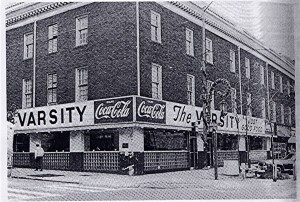
An old The Varsity restaurant. Notice the Coke sponsorship and how large the restaurant is for its time.
Of all the places I have visited in Atlanta, The Varsity was one of the most interesting experiences. This class over the semester has opened my eyes in a way. I have been to The Varsity more than I have even stepped into actual Atlanta. This restaurant is very familiar to me, as my mom grew up in East Point and would be treated with a meal for a job well done after cheer leading. She kept the same tradition with me through my adolescents.This time that I walked in, it seemed different from before.
After taking the 1.5 mile walk from the commons, through Midtown, and onto the crest of Georgia Tech, I saw The Varsity’s bright red sign. The same faded water spots, cracked gravel, and puddles greeted me and brought a feeling of nostalgia. I opened the doors and could smell the various fried foods and heard the hum of the stove in the distance. This is how I remembered every special occasion to come out to Atlanta and get this honor of a meal. I ordered my favorite, a frosted orange, and sat down to begin note-taking. It was only then that I began to realize something that I have never realized before.

Photo taken at 11:20 in the space that I was in. Notice the lack of people present at this time. PB:M.Molini
I thought that it would be an interesting idea to note take the various demographics that attended the establishment. I started the clock at 11:20 and let it run for 20 minutes. I chose these times because I knew that it was on the beginning of lunch and thought it would be an interesting survey. Now I am aware that The Varsity is a major hub of tourists so I based these solely on my observations and appearance due to skin color. I started by counting three African American customers, two African American employees, and seventeen Caucasians. By the end of this time, I noticed the same three African American Customers, two African American employees, but the rapid increase of Caucasians to an exponential number of 53.
This survey was only done on the side of the restaurant that I was sitting on, at most a fourth of the total area. This surprised me a great deal, but then it clicked. Sitting there I noticed the signage, the atmosphere, the culture, it was all meant to take place in the early to mid 19th century.
Why would African Americans eat at an establishment that modeled itself after an era so close to the civil rights movement. There were posters, artifacts, and photos from the decade that had no evidence of these revolutionary times. I then got up and began to look around the entire restaurant to get a better view. There were chili promotions, with a white model, there were Coke promotions, with a white model, there were old photos, with exclusively white customers. The paradox built when after realizing all of these bias artifacts, I counted twelve African American employees behind the counter and not a single white worker.
The point I am trying to make is related to the customers. There seems to be nothing comforting to the African American culture found inside The Varsity. It was a big moment for me because it made me think about architectural racism and that people can be so blind to the incredible bias that can be standing right in front of their eyes. Could these themes of The Varsity on one side be a nostalgia but on the other be a reminder of difficult times for African Americans? Could that be the reason that minorities do not eat there? Does The Varsity not encompass enough of the culture at the time? My honest answer is that I don’t know.

This is a photo taken at 11:40. There are more people within the restaurant, most of them Caucasian. PB:M.Molini
Its a difficult argument to make, but I do think that it is present. Now I might have just been there on a weird day or have just not taken into account the time, but I think that it is a relevant idea. Could places that memorialize these times be hurting us more than they help us? I think in some ways they are. They don’t paint history in any other point of view than the white-washed version. There is a bias. That is why I think that of the many streets,companies, and shops, The Varsity is one of the most interesting spots in Atlanta.

3 Comments
Your personal site response was great but I recommend to maybe post this in 3 different posts and linking them together. You can earn more points that way.
I wonder, too, if these spaces can build in nostalgia, but in a more honest, inclusive way? Any ideas?
I would think an idea should be to have art that is not just representative of white culture, but also of black. There should be photography that doesnt represent African Americans as a worker but also as equals within the society. Maybe, at the VERY least, show that the culture was there and that the times were not just of white people having fun but innovations in music and art that non-white created and attributed to. My whole thing was the the black and white photos only showed the white, and ignored the black.